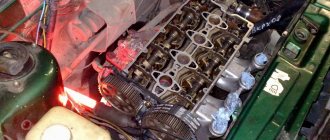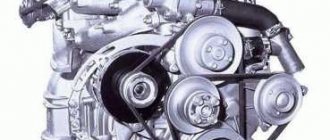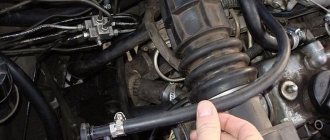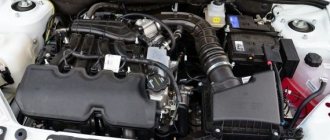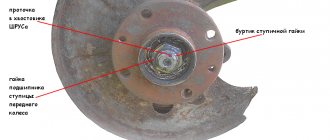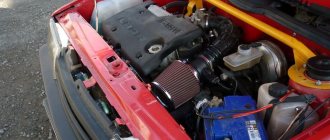Many car owners do not even think about the order of operation of the engine cylinders of their car, limiting themselves only to knowing their number. Such information is not needed to drive a vehicle and most drivers do not see the point in studying technical details.
Understanding the process turns out to be useful for setting the ignition, replacing the timing belt and other types of work during independent adjustment or repair, when it is not possible to seek help from a service station.
8 valve engine design
Such engines are used mainly on models in the entry-level price segment. Here there are 2 valves per cylinder: 1 for intake and 1 for exhaust.
Another important feature of such power plants is that only 1 camshaft is needed, which controls the gasoline injection and exhaust gas exhaust system. To operate it, a simple belt or chain mechanism is sufficient. Such a system is much easier to maintain and repair compared to complex timing belts of more expensive cars. And such an elementary design significantly affects the final cost of the car.
As an example, we give a diagram of the design of an 8-valve VAZ-2114 engine.
1) generator drive pulley; 2) oil pump; 3) timing belt; 4) coolant pump timing belt; 5) front cover of the timing mechanism drive; 6) tension roller; 7) camshaft toothed pulley; camshaft drive rear cover; 9) camshaft oil seal; 10) cylinder head cover; 11) camshaft; 12) front camshaft bearing cover;
2) oil pump; 3) timing belt; 4) coolant pump timing belt; 5) front cover of the timing mechanism drive; 6) tension roller; 7) camshaft toothed pulley; camshaft drive rear cover; 9) camshaft oil seal; 10) cylinder head cover; 11) camshaft; 12) front camshaft bearing cover;
13) pusher; 14) valve guide; 15) oil separator mesh for the crankcase ventilation system; 16) exhaust valve; 17) inlet valve; 18) rear camshaft bearing cover; 19) fuel pump; 20) housing of auxiliary units; 21) ignition distributor sensor; 22) cooling jacket outlet pipe; 23) cylinder head; 24) spark plug; 25) crankcase ventilation hose;
26) flywheel; 26) flywheel; 27) crankshaft rear oil seal holder; 28) rear crankshaft oil seal; 29) cylinder block; 30) oil pan; 31) oil level indicator (oil dipstick); 32) crankshaft; 33) piston; 34) connecting rod cover; 35) connecting rod; 36) crankshaft main bearing cover; 37) front crankshaft oil seal; 38) crankshaft toothed pulley.
Valves, their purpose, operation of a 4-stroke engine
The engine valve is both a part and the last link of the gas distribution mechanism. It is a spring-loaded element that, when at rest, blocks the inlet or outlet. When the camshaft rotates, the cam located on it presses on the valve and lowers it, thereby opening the corresponding hole
At least two valves are installed on each cylinder. More expensive engine models have four of them. In most cases, the number of valves is even, their purpose is to open different groups of holes: some are intended for inlet, the other for exhaust.
Intake valves open the passage for a new portion of the air-fuel mixture entering the cylinder, and in engines with direct fuel injection, a volume of air. This process occurs at the moment the piston performs intake (moving down from the top “dead” point after removing combustion products).
Exhaust valves work on the same principle, but perform a different function. They are designed to remove exhaust gases into the exhaust manifold. The operating cycle of a 4 cylinder engine is a sequence of four processes called the "duty cycle". Let's consider it using the example of a gasoline four-stroke internal combustion engine installed in most passenger cars.
1. Inlet.
In the combustion chamber, energy conversion begins and the first stage is the combustion reaction of the air-fuel mixture. In this case, the piston moves down from top dead center, a vacuum occurs and fuel is injected. At this time, the inlet valve is open, the outlet valve is in the closed position. In injection engines, fuel is supplied by a nozzle.
2. Compression.
After the combustion chamber is filled with a mixture of gasoline vapor and air, the piston moves to the lower position during rotational movements of the crankshaft. The intake valve gradually closes, but the exhaust valve remains closed.
3. Working stroke.
The third stage of the work cycle is the most important. It is here that the energy of the burning fuel turns into mechanical energy, driving the crankshaft.
Even during the compression process, when the piston is located at the top point, the fuel mixture is ignited by a spark from the spark plug. The fuel charge burns quickly, and the resulting gases are under maximum pressure in the small space of the combustion chamber.
As the piston moves downward, the gases expand rapidly, releasing energy. At this stage, acceleration acceleration is transmitted to the crankshaft. At all other strokes of the cycle, the engine only receives energy from the crankshaft without producing it.
4. Release.
This is the last stroke of the work cycle. On it, gases that have completed useful work are released from the cylinder, freeing up space for the next portion of the air-fuel mixture to enter.
At this stage, the gases are under pressure significantly higher than atmospheric pressure. The crankshaft moves the piston through the connecting rod to top dead center. The exhaust valve opens and gases are pushed out through the exhaust system.
The operating cycle of diesel engines is somewhat different from gasoline engines. At the inlet, only air is sucked in, and fuel is injected into the combustion chamber by the fuel pump after compressing the air mass. Diesel fuel ignites when it comes into contact with compressed air.
Pros and cons of an 8 valve engine
This engine design, despite its venerable age, has many advantages:
- simplicity of design - an 8-valve engine has significantly fewer wearing parts, and accordingly, its repair will be easier and cheaper;
- lack of hydraulic compensators - motors of this type simply do not need them, so the design is further simplified and cheaper;
- less demanding on oil characteristics - 8-valve engines allow the use of lower quality lubricant, which is noticeably cheaper;
- less sensitivity to the quality of gasoline - most of the 8-valve valves used today were developed at a time when there was no better fuel than 92;
- small size - one camshaft takes up much less space, so such engines are more compact than their 16-valve counterparts, and this makes access to attachments easier.
However, there are also many significant disadvantages:
- less power - intake and exhaust through 2 valves significantly limits the amount of fuel supplied to the cylinders and the total engine power;
- slightly higher fuel consumption - the reduced throughput of 1 pair of valves forces the engine to put more effort into pushing exhaust gases into the manifold, and accordingly more energy is spent on this;
- noise at high speeds - the pushers wear out during engine operation, gaps form, which is why the engine begins to make noticeable noise;
- the need for more frequent valve adjustments - if this is ignored, engine performance will drop, and fuel consumption, on the contrary, will increase.
Multi-valve engines
When bottom valve engines became a thing of the past, the valves moved up to the head of the block, and their arrangement has not changed since then.
To avoid long pushers, which limited the ability to boost the engine speed (this design is inertial and non-rigid), the camshaft was moved to the head of the block, which ended the transformation. Then only the compression ratio and rpm increased. But although a high-speed engine is suitable for racing (though not for everyone), it is not suitable for everyday use: the requirements for the materials from which the parts are made, fuel and oils are high, exhaust toxicity and operating costs are high. I had to look for other ways. The area of four inscribed circles is greater than two; the flow area of the channels, which are covered by valves, is correspondingly larger
.
The idea of an engine with four valves per cylinder cannot be called particularly original or innovative, but it cannot be denied that it is a fairly simple way to improve the filling of the cylinder with a combustible mixture and the removal of exhaust gases from it. Draw a circle and fit two others of the maximum possible diameter into it, and then try to draw the same thing, but with four. The large circle represents the cylinder, and the small circles represent the channels closed by valves. The naked eye can see in which case the area occupied by the inscribed circles is larger and, therefore, the flow area of the intake and exhaust channels in the engine head is larger. Four valves “descended” from the heights of Formula 1, first to other racing cars, then to simpler sports cars, and now they are vigorously “marching” from expensive cars to the middle class and further, to small and cheap ones (this stage began in the early 1990s ).
Typical engine timing diagram (Mazda 121)
: the camshaft is highlighted in green, valves with springs and fixing parts are highlighted in brown. Interestingly, the camshaft arms are made of light alloy (shown in yellow) and equipped with steel rollers (red). Visible are the screws for adjusting the gap with locknuts and the spark plug (these parts are white).
An engine with four valves per cylinder does not necessarily have two camshafts in the head, as car enthusiasts sometimes think. There are engines in which the valves are driven by a single shaft, for example in the Mazda 121.
Mitsubishi Galant car engine
: two camshafts, hydraulic valve lash compensators - typical for four-valve engines.
The engine of the more expensive Mitsubishi-Galant already has two camshafts and hydraulic valve clearance compensators. Note that the dual camshaft design is used more often in four-valve engines. There are engines with three valves per cylinder: several such models are used, for example, by Toyota on Starlet and Corolla cars. In this case, two valves are inlet and one is exhaust. This is due to the fact that a larger cross-section is required for the intake: the working mixture passes through narrow channels worse than exhaust gases. When Opel added fashionable all-wheel drive to the modifications of its Vectra, it almost stumbled. The inert transmission and increased weight of the car almost negated its advantages compared to the front-wheel drive. A new head with four valves per cylinder helped save the situation. Power has increased, dynamics and speed have grown to match the all-wheel drive ambitions. This is an example of real design success. If the cross-section of the channels is larger, this does not mean that more fuel enters the cylinders and the flow rate should be higher. Multi-valve engine heads allow you to change the distribution of the working mixture in the combustion chamber, reduce intake losses and reduce the amount of exhaust gases remaining in the cylinders. All this increases the efficiency of the engine, therefore, it becomes possible to reduce consumption, at least in some modes. The engine does not consume as much fuel as it enters the cylinders; the injection system “determines the dose” according to the wishes of the designers. But developers are sometimes forced to make concessions, for example, to use high-octane gasoline. Of course, you can improve the performance of a car not only by changing the engine design (increasing the number of valves). Often, at the same time, gear ratios in the gearbox are changed, the fuel injection system is modified, etc. But still, leading companies widely use four-valve engines. In modern production conditions, the costs of producing a technologically more complex cylinder head are small, and the increased price of the car, as a rule, is justified by good characteristics and does not scare off the buyer. Some people drive four-valve cars without even realizing it. Automotive companies sometimes mention the design only in the technical specifications: after all, the consumer is concerned with performance indicators, and not the design of the engine. Others, on the contrary, strive to emphasize the technical level or sporting qualities of the model, then the designations “16V” and “24V” appear in the name. The first says that the engine has four cylinders and four valves per cylinder, for a total of sixteen, and the second says that there are six cylinders, four valves each (6X4 = 24). Indices of three-valve engines “12V”, “18V”. The same inscriptions may be on the valve cover, and in addition to them “DOHC” and “Twincam”, which means “two camshafts in the head”. If there is no “12V” or “24V” next to “DOHC,” then the engine does not necessarily have a four-valve engine: a regular, two-valve engine can also have two camshafts.
16 valve engine design
In such 4-cylinder engines, each cylinder already has 2 pairs of intake and exhaust valves. To operate such a system, 2 camshafts are required. And for their coordinated work, a much more complex gas distribution mechanism is used. At the same time, 2 intake valves allow more fuel to be supplied to the cylinders per stroke - and hence a significant increase in power and efficiency. At the same time, fuel consumption is reduced thanks to the presence of 2 exhaust valves.
Hydraulic compensators are often used to press the valves against the shaft in such engines. Unlike 8-valve valves with mechanical pushrods, this system operates smoother and quieter. It also provides an additional increase in power and additional fuel economy.
Another specific feature of 16-valve engines, which becomes especially relevant against the backdrop of ever-tightening environmental requirements, such engines, due to more precise operation of the gas distribution mechanism, are safer for the environment.
For example, here is a diagram of the design of a 16 valve VAZ 2112 engine.
1) engine oil pan; 2) front crankshaft oil seal; 3) crankshaft; 4) crankshaft pulley; 5) oil pump; 6) generator drive pulley; 7) timing belt; front cover of the timing mechanism drive; 9) coolant pump pulley (pump); 10) tension roller; 11) camshaft toothed pulley; 12) rear cover of the timing mechanism drive; 13) camshaft oil seal;
2) front crankshaft oil seal; 3) crankshaft; 4) crankshaft pulley; 5) oil pump; 6) generator drive pulley; 7) timing belt; front cover of the timing mechanism drive; 9) coolant pump pulley (pump); 10) tension roller; 11) camshaft toothed pulley; 12) rear cover of the timing mechanism drive; 13) camshaft oil seal;
14) exhaust camshaft; 15) hydraulic pusher; 16) valve spring; 17) valve guide; 18) exhaust valve; 19) receiver; 20) camshaft bearing cover; 21) guide pipe; 22) cylinder head cover; 23) plastic cover; 24) spark plug; 25) intake camshaft; 26) inlet valve; 27) cylinder head; 28) coupling;
29) fuel rail; 30) crankcase ventilation hose; 31) nozzle; 32) intake manifold; 33) flywheel; 34) crankshaft rear oil seal holder; 35) rear crankshaft oil seal; 36) cylinder block; 37) oil dipstick; 38) piston; 39) connecting rod; 40) connecting rod cover; 41) crankshaft main bearing cover.
How many cylinders are there in an engine?
Throughout the history of mechanical engineering, engineers and designers have pursued one goal - obtaining maximum efficiency from the engine. To achieve this, more and more powerful engines were developed with varying numbers of cylinders - from 1 to 16, and attempts were made and continue to be made to place “horsepower” in the smallest possible volume of engine compartment space.
Single-cylinder engines are installed in mini-tractors, low-power mopeds and motorcycles. For more powerful motor vehicles, a 4-stroke 2-cylinder engine is required. Modern three-cylinder internal combustion engines are mainly installed on small cars and are equipped with a turbine to increase power.
Important
4-cylinder engines have been the most popular in the automotive industry for over a hundred years. Almost all modern passenger cars are equipped with them.
Five-cylinder engines are not so popular. Previously, they were widely used by such giants of the global automotive industry as Volkswagen, Volvo, Audi
Six and 8 cylinder engines are also popular. Despite the worldwide practice of reducing the number of cylinders due to turbocharging, such internal combustion engines are gradually losing their positions. In recent years, many automakers have been abandoning eight-cylinder engines in favor of 6-cylinder engines, this is especially noticeable in the market for powerful passenger cars.
ICEs with 7 or 9 cylinders are used in aircraft. They are not used in the automotive industry, with rare exceptions - in tuned models. 10- and 11-cylinder engines are also very rare in the automotive industry. You can admire the “ten” in the Audi R8 sports car.
The 12-cylinder engine was used more widely in the auto industry. But due to tightening environmental regulations, their production is inexorably declining.
There are also internal combustion engines with 14, 16, 18, 20, 24, 28, 32 and 64 cylinders. They are a combination of several engines with fewer cylinders and are practically not used in automobile production.
Pros and cons of a 16 valve engine
So, here are the main advantages of 4-cylinder engines with 16 valves:
- significant increase in power, increased maximum speed and dynamics;
- lower fuel consumption and environmental friendliness;
- much lower noise level;
As you can see, the advantages of such engines are significant. But they also have significant disadvantages:
- hydraulic compensators are very sensitive to oil quality, it is recommended to use only synthetic oil;
- for efficient operation of the “four” with 16 valves, you need high-quality gasoline, ideally not lower than AI-95;
- Structurally, such engines are much more complex, in particular, replacing the timing belt here, as a rule, costs several tens of thousands of rubles;
- The motor itself is larger, which makes access to attachments more difficult.
Reliability, weaknesses, maintainability
These three main indicators complement the technical characteristics of the engine in sufficient detail and give a more complete picture of the power unit.
Reliability
VAZ-21114 is one of the few engines with high reliability. Car owners have repeatedly spoken about this on forums. Car service technicians share the same opinion.
For example, the engine of a Lada Kalina 1117 with a mileage of 130 thousand km was inspected. The result was amazing. The pistons are clean, the hone on the cylinder walls is preserved, and there is no carbon deposits on the valves.
The car owner draws attention to the fact that the oil was changed after 7-8 thousand km, and the gasoline for the first 90 thousand km was exclusively AI-95, then it was replaced with AI-92.
Reliability is clearly evidenced by the fact that with a lifespan of 150 thousand km declared by the manufacturer, the engine lasts for more than 300 thousand without repair. And this is not the limit.
The engine has a large margin of safety. With proper tuning, its power can be increased to 180 hp. With. It should be taken into account that such modification of the motor is very complex, expensive and significantly reduces the declared service life.
The reliability of the motor is significantly increased by reducing the maintenance time, using high-quality technical fluids and its reasonable operation.
Weak spots
In general, the VAZ-21114 is considered a successful power unit, but it failed to avoid weak points. According to reviews from car owners and car service workers, the engine has all the VAZ “sores”.
Tendency to overheat. Many have had to deal with this unpleasant phenomenon during operation. The most common cause of overheating is a thermostat and water pump that were not properly adjusted by the manufacturer. If a problem occurs, they will have to be replaced with new ones. There is no other way out of this situation.
Unstable idle speeds cause a lot of trouble. As a rule, they occur when sensors (mass air flow sensor or air flow sensor) fail. Less commonly, due to contamination of fuel supply system elements.
Failed sensors must be replaced. The fuel system needs to be flushed. The malfunction in the first case occurs due to the fault of the plant, and the second falls almost entirely on the shoulders of the car owner.
Refueling with low-quality fuel and untimely maintenance are the main components that cause clogging of the fuel system.
Electrical malfunctions. In this case, the author of the malfunctions is, just like the thermostat and pump, an unfinished ECU (21114-1411020). In addition, the engine often stalls and jerks at idle due to a faulty ignition coil.
Four-terminal ignition coil
The same behavior of the motor can be caused by burnt-out valves if their thermal clearance is not adjusted in a timely manner.
Minor “standard” problems do not bring joy to the car owner, such as oil leaks from under the valve cover, malfunctions of the fuel pump, unauthorized knocking in the engine compartment (usually unadjusted valves knock).
If any malfunction occurs, you must immediately seek help from specialized car service specialists. Timely detection and elimination of the problem in most cases saves the car owner from serious (and therefore costly) engine repairs.
Main differences between 16 and 8 valve engines
We have figured out the features of these types of engines, now we will specify the differences between them.
8-valve engines are much simpler in design, which has a positive effect on the price of the entire car, its maintenance and repairs. However, they are significantly inferior in power to 16-valve analogues with the same displacement - on average, the difference in power here is 15-25 hp. Because of this, engine response, acceleration dynamics, and maximum speed suffer.
At the same time, 4-cylinder engines with 8 valves are much simpler and more affordable to repair. There are significantly fewer elements that can break, and if something does break down, the breakdown can be repaired with less effort. And spare parts for such engines are usually cheaper.
With efficiency, everything is not so clear. Yes, 8-valve engines consume more fuel - but at the same time, they can be filled with lower quality, inexpensive gasoline. Oil may not be the most expensive either. Another controversial point is the use of hydraulic compensators. They are installed on 16-valve engines and eliminate the need for systematic valve adjustment. At the same time, they sometimes fail, and replacing them will cost a pretty penny.
One more important point should also be noted: in 16-valve engines, the piston and valves can jam together - and this inevitably leads to costly repairs, and sometimes to a complete replacement of the engine. In principle, 8-valve patients do not have such a disease. However, such jamming occurs, as a rule, on Russian and Chinese cars, which by default are inferior to the Western and Japanese automobile industry.
Description
The VAZ-21114 engine was created in 2004. It was first presented to the general public in the same year at the AvtoVAZ auto show. The basis for the development of the new power unit was the famous VAZ-2111. Essentially, the new engine is an improved version of its predecessor.
ICE production has been established in Tolyatti. Engine production continued until 2013.
Initially, it was planned to equip the promising Lada Kalina and Lada Priora with this unit. But later this engine began to be installed on other car models.
The VAZ-21114 is a gasoline in-line four-cylinder aspirated engine with a volume of 1.6 liters and a power of 81.6 hp. s and a torque of 125 Nm.
VAZ-21114 engine under the hood
Installed on Lada cars:
- VAZ 2110 /sedan/ (2004-2007);
- VAZ-2112 /hatchback/ (2004-2008);
- VAZ-2111 /station wagon/ (2004-2009);
- Samara 2114 /hatchback/ (2005-2013);
- Samara 2115 /sedan/ / (2007-2012);
- Samara 2113 /coupe/ (2007-2013);
- Priora 2170 /sedan/ (2007-2011);
- Priora 2172 /hatchback/ (2008-2011);
- Kalina I /hatchback/ (2006-2013);
- Kalina I /station wagon/ (2007-2013).
The main engine blocks (BC, cylinder head, camshaft, valves, crankshaft) are structurally similar to those on the VAZ-11183.
The cylinder block is cast iron. Compared to the block from the VAZ-2110, it has a slightly increased height (by 2.3 mm).
The cylinder head is aluminum, with one camshaft and 8 valves. There are no hydraulic compensators, so the thermal clearance of the valves must be adjusted manually every 45 thousand km of the vehicle.
Adjustment is carried out by selecting steel adjusting washers installed on the pushers. A special feature of the cylinder head is the enlarged combustion chamber (81x50 mm). The head cover is also aluminum. A gasket is installed between the cylinder head and the valve cover. Head index 11180.
Cylinder head VAZ-21114
Aluminum pistons with three rings. The top two are compression, the bottom is oil scraper. The piston bottoms have recesses for the combustion chamber and valves. Thus, if the timing belt breaks, the piston does not meet the valves.
The connecting rods are made of steel by forging. Inserts are installed in the lower heads, steel-bronze bushings are pressed into the upper ones.
The crankshaft is cast from high-strength cast iron. The crank radius was increased by 2.3 mm in comparison with the VAZ-2112 crankshaft, which made it possible to increase the piston stroke to 75.6 mm. To balance second-order inertial forces, it has eight counterweights. Main bearings are steel-aluminum liners.
Timing belt drive. The service life of the belt is 100 thousand km, but car service experts advise reducing it to 70-80 thousand km.
The camshaft is made of cast iron and differs from the VAZ-2111 shaft. A pin is installed at the rear end to ensure the operation of the phase sensor. The working surfaces of the cams are subjected to special heat treatment using the bleaching method.
A special feature of the electrics is the use of a four-terminal high-voltage coil instead of an ignition module. The entire electronic system is controlled by ECU M7.9.7 or January 7.2. The operation of the electrical part of the internal combustion engine is provided by an 80-amp generator.
The lubrication system is made according to the classical scheme. The design does not provide oil nozzles for cooling the piston heads.
The fuel system has lost its return line. Siemens (yellow) or Bosch injectors are installed in the ramp. Phased fuel injection.
Dependence of power and torque on revolutions
From the presented graph it is clearly visible that the motor in question has quality characteristics similar to those of more modern engines.
The description clearly shows that the design of the VAZ-21114 is not difficult. And this is already one of the indicators of its reliability (but more on that below).
Which is better 16 valves or 8
So, let's try to determine which option and in which situation will still be preferable. New cars with 4-cylinder engines offered in showrooms are almost always equipped exclusively with 16-valve engines; such engines have already displaced the outdated 8-valve design from the market. However, some manufacturers, usually from the lower price segment, still have such simplified options. Their main advantage is just a more affordable price.
But, if you have the opportunity to pay extra, the car is chosen for personal, not commercial use, and you are not going to service it yourself, then it would be more reasonable to buy a car with a 16-valve engine. It will delight you with higher power and dynamics, as well as efficiency and reduced noise.
In a situation where the car is taken from hand, 8-valve options may be preferable. The fact is that they are structurally simpler and more unpretentious in the choice of fuel and oil, respectively, here the chance of getting a car with a “live” and peppy engine will be higher than in the case of more sensitive 16-valve engines.
It is impossible to say unequivocally which option is better. It is necessary, first of all, to take into account your own goals and objectives, financial capabilities, and the conditions in which the car will be operated. If your primary requirements are reliability and unpretentiousness, then it makes sense to take a closer look at the 8-valve modifications. If speed and power are important to you, then it is better to choose 16-valve engines.
The order of operation of the cylinders and why this is so
There are two types of 4 cylinder engines:
- in-line;
- Opposite.
The crankshaft layout is the same, but the order of operation of the cylinders is different. This is due to differences in the design of the gas distribution mechanism, ignition system, and also depends on the angles between the crankshaft cranks.
The in-line 4-cylinder engine operates in a 1-3-4-2 operating order. It is used in the vast majority of cars - both diesel and gasoline, from Lada to Mercedes. Here, cylinders located on opposite journals of the crankshaft operate sequentially. The order of operation of the cylinders of a 4-cylinder opposed internal combustion engine is organized in a different sequence: 1-3-2-4 or 1-4-2-3.
In this case, the pistons reach top dead center on both sides at the same time. “Opposed” cars can be seen on almost all Subaru models, with the exception of some small cars sold on the domestic market.
Inlet/exhaust valve VAZ-2112 set 16 pcs. AvtoVAZ 21120100701086 — Leave a review
Article: 21120-1007010-86, additional articles: 21120100701086, 2112-1007010
Order code: 673460
- Add photo
- Buy analogues
- Passenger cars / VAZ / VAZ-21114 drawings
» href=»/catalog/vaz-3/legkovye_avtomobili-30/vaz_2111-11/mehanizm_gazoraspredelitelnyiy-102/#part44678″>Intake valveEngine / Gas distribution mechanism - » href=»/catalog/vaz-3/legkovye_avtomobili-30/vaz_2111-11/mehanizm_gazoraspredelitelnyiy-102/#part44681″>Exhaust valveEngine / Gas distribution mechanism
- » href=»/catalog/vaz-3/legkovye_avtomobili-30/vaz_2111-11/mehanizm_gazoraspredelitelnyiy-102/#part44679″>Intake valveEngine / Gas distribution mechanism
- » href=»/catalog/vaz-3/legkovye_avtomobili-30/vaz_2111-11/mehanizm_gazoraspredelitelnyiy-102/#part44680″>Exhaust valveEngine / Gas distribution mechanism
- » href=»/catalog/vaz-3/legkovye_avtomobili-30/vaz_2110__2111__2112-415/mehanizm_gazoraspredelitelnyiy-116/#part1302730″>Intake valveEngine / Gas distribution mechanism
- » href=»/catalog/vaz-3/legkovye_avtomobili-30/lada_kalina_1119_sport-1556/mehanizm_gazoraspredelitelnyiy-16/#part3438762″>Intake valveMain engine elements / Gas distribution mechanism
- » href=»/catalog/vaz-3/legkovye_avtomobili-30/lada_priora_21728_coupe-1878/mehanizm_gazoraspredelitelnyiy-62/#part4189876″>Intake valveMain engine elements / Gas distribution mechanism
- » href=»/catalog/vaz-3/legkovye_avtomobili-30/lada_priora_2170__fl-1889/a151__mehanizm_gazoraspredelitelnyiy-121/#part4223698″>Exhaust valveMain elements of the engine / A151. Gas distribution mechanism
- » href=»/catalog/vaz-3/legkovye_avtomobili-30/lada_vesta-1883/114200__grm__raspredval__klapana_-132/#part4202711″>EXHAUST VALVE ASSEMBLY Gas distribution system / 114200. Timing belt (camshaft, valves)
- » href=»/catalog/vaz-3/legkovye_avtomobili-30/vaz_2110-10/mehanizm_gazoraspredelitelnyiy-102/#part40373″>Exhaust valveEngine / Gas distribution mechanism
- » href=»/catalog/vaz-3/legkovye_avtomobili-30/vaz_2112-12/mehanizm_gazoraspredelitelnyiy-102/#part48989″>Exhaust valveEngine / Gas distribution mechanism
- » href=»/catalog/vaz-3/legkovye_avtomobili-30/lada_priora_2170-480/mehanizm_gazoraspredelitelnyiy-76/#part1578880″>Intake valveEngine / Gas distribution mechanism
- » href=»/catalog/vaz-3/legkovye_avtomobili-30/lada_kalina_2192__2194-1646/mehanizm_gazoraspredelitelnyiy-27/#part3652605″>Exhaust valveMain engine elements / Gas distribution mechanism
- » href=»/catalog/vaz-3/legkovye_avtomobili-30/lada_kalina_2194-1886/a151__mehanizm_gazoraspredelitelnyiy-101/#part4210126″>Exhaust valveMain elements of the engine / A151. Gas distribution mechanism
- » href=»/catalog/vaz-3/legkovye_avtomobili-30/lada_granta_2190-1893/a152__mehanizm_gazoraspredelitelnyiy-98/#part4242591″>Exhaust valveMain elements of the engine / A152. Gas distribution mechanism
Recommendations for improvement
For the first time, it was decided to increase the power of the new Priora 21126 engine at the factory in order to create a sports modification of it. Camshafts with increased lift, a lightweight connecting rod and piston group were installed, and the intake and exhaust tracts were modified. This is how the first domestic sports unit appeared, which was put into production, and they began to install it on the Lada Granta Sport model.
The technical characteristics of the engine are as follows: engine power from the Priora has increased to 118 hp. torque - up to 154 Nm at 4700 rpm, fuel consumption also increased to 7.8 liters per 100 km with a combined driving cycle. We will give a number of recommendations on how to independently increase the power of Priora engines:
- The simplest and most affordable way is to install a zero-resistance exhaust tract. The essence of its work is to reduce the resistance of the path, as a result of which some of the power spent on overcoming this resistance will be released and become useful.
- The same operating principle applies to the zero-resistance intake tract. Installing the receiver and throttle body to 56 mm will allow the power unit to “breathe” more freely, and your Lada Priora will become several horsepower more powerful.
- Deeper tuning - new camshafts with a sports configuration, allowing the intake and exhaust valves to open more. This will give a noticeable increase in the agility of the car, especially in city conditions.
- Replacing the standard valves and connecting rod-piston group with a lightweight one will again release some of the useful energy of the unit and add it to the main power. Here you can kill two birds with one stone: install pistons with recesses, thereby eliminating the possibility of them “meeting” with the valves when the timing belt breaks.
- We should not forget about CHIP tuning. After major changes in the engine configuration, its operating mode will definitely improve, and in order to optimize it and adjust fuel consumption, you need to do a flashing.
Recommendations are given taking into account that the power plant is in good technical condition. If this is not the case, when tuning it is worth replacing worn parts and oil in order to get the desired effect from the changes. As a result of the above measures, the Lada Priora will receive an additional 20-30 hp. without reducing the resource.
How many horses can Priora have in addition to this? Quite a lot, there are capabilities and components to increase the power ultimately to 400 hp. This is due to a radical modification of the power plant: boring the cylinders, grinding the cylinder head, replacing the injectors and fuel pump with more efficient ones, installing four throttle valves and a turbocharger.
We should not forget about modernizing the brake system. Such tuning will give excellent results in terms of power, but the engine life will be significantly reduced, and fuel consumption, on the contrary, will increase significantly.
